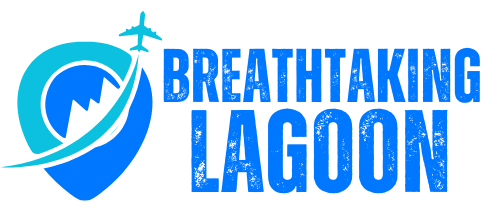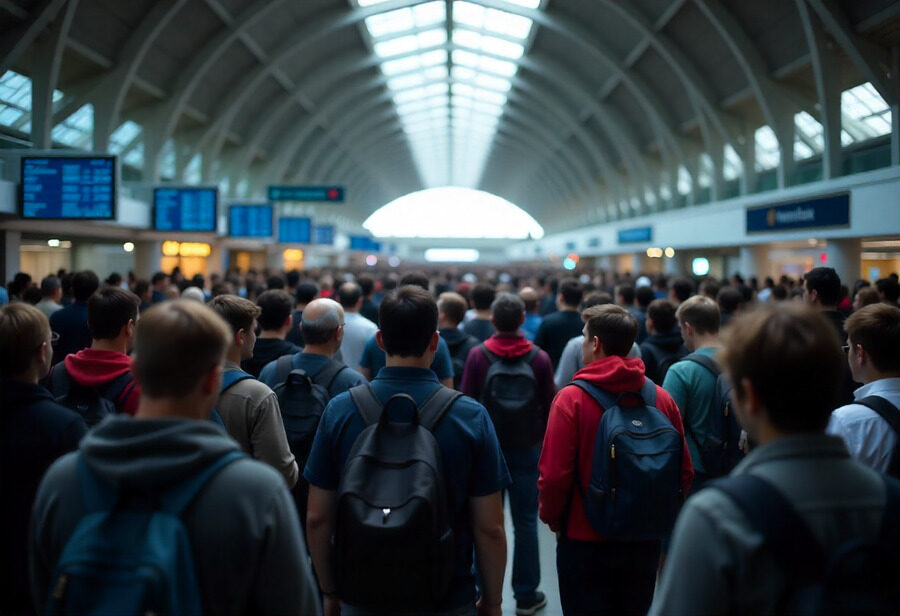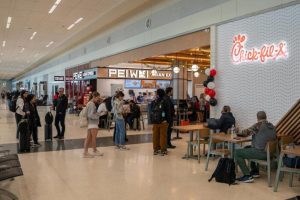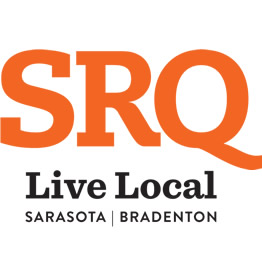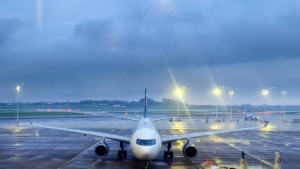Published on October 26, 2025
Thousands of travelers are isolated across the US as Horizon, American, Delta, SkyWest, JetBlue, and other airlines cancel 172 flights and cause 4,861 delays, resulting in widespread chaos at airports in Fort Smith, Portland, Dallas, McAllen, Miami, and New York City. The massive disruptions, driven by a combination of operational issues, weather delays, and staffing shortages, have left passengers stranded, scrambling for rebooking, and facing long waits at already overwhelmed airports. Major travel hubs have been heavily impacted, with travelers experiencing frustration and confusion as they try to navigate the chaotic situation.
As the chaos from recent flight cancellations and delays continues to disrupt air travel across the United States, thousands of travelers are facing significant inconveniences. On a single day, 172 flights were canceled, and 4,861 flights were delayed within, into, or out of the United States. A number of major airports in the country, including Dallas-Fort Worth, Chicago O’Hare, Newark Liberty, and Miami International, were severely impacted, stranding passengers and causing a ripple effect across the aviation network.
The Scope of the Disruption
The total number of delays and cancellations reported for the day paints a grim picture for the aviation industry:
- Total Delays: 4,861 flights (47% of all flights)
- Total Cancellations: 172 flights (4% of all flights)
This wave of delays and cancellations is one of the most disruptive in recent months, affecting not only passengers but also airlines and airport operations nationwide.
Impacted Airports
Some of the busiest airports across the United States experienced substantial disruptions:
- Dallas-Fort Worth International (DFW):
- Cancellations: 48 (4%)
- Delays: 488 (47%)
Dallas-Fort Worth was one of the hardest-hit airports, accounting for a significant portion of the nationwide flight cancellations and delays. The disruption affected travelers across multiple airlines, with American Airlines and other carriers seeing major impacts.
- Chicago O’Hare International (ORD):
- Cancellations: 5 (0%)
- Delays: 245 (19%)
Chicago O’Hare, another major hub, experienced delays that rippled throughout the day, frustrating passengers trying to make connections or reach their final destinations.
- Newark Liberty International (EWR):
- Cancellations: 5 (0%)
- Delays: 191 (36%)
Newark also faced significant delays, particularly affecting travelers on long-haul flights, with severe ripple effects on the surrounding air network.
- Miami International (MIA):
- Cancellations: 4 (0%)
- Delays: 92 (13%)
Miami, which serves as a key international gateway, was also disrupted by the cancellations and delays, affecting many international passengers.
- Seattle-Tacoma International (SEA):
- Cancellations: 4 (0%)
- Delays: 96 (16%)
Travelers at Seattle-Tacoma faced issues with both canceled flights and delays, complicating outbound and inbound travel.
Other airports like Los Angeles International (LAX), San Francisco International (SFO), Houston Bush Intercontinental (IAH), and John F. Kennedy International (JFK) also faced their share of disruptions, with delays in the range of 10% to 30%.
Advertisement
The Airline Impact
Advertisement
Several major airlines were directly involved in the mass flight cancellations and delays:
- American Airlines:
- Cancellations: 57 (1%)
- Delays: 873 (26%)
American Airlines accounted for the highest number of cancellations and delays on the day, further compounding the travel disruptions, especially at hubs like Dallas-Fort Worth and Chicago O’Hare.
- Envoy Air:
- Cancellations: 27 (2%)
- Delays: 250 (25%)
As a regional carrier for American Airlines, Envoy Air saw a significant number of delays, especially affecting passengers on shorter domestic flights.
- United Airlines:
- Cancellations: 23 (0%)
- Delays: 671 (24%)
United Airlines faced major delays, particularly on flights departing from or arriving at major airports like Chicago O’Hare and Newark Liberty.
- Alaska Airlines:
- Cancellations: 13 (1%)
- Delays: 166 (23%)
Alaska Airlines, known for its service on the West Coast, experienced widespread delays that extended into the evening, affecting both domestic and international connections.
- Delta Air Lines:
- Cancellations: 8 (0%)
- Delays: 356 (11%)
Delta’s operations were disrupted by delays, especially on routes flying out of busy airports like Los Angeles and Miami.
- SkyWest Airlines:
- Cancellations: 7 (0%)
- Delays: 391 (16%)
SkyWest, a regional carrier, was heavily impacted by delays, particularly affecting flights to and from smaller airports and connecting hubs.
- Southwest Airlines:
- Cancellations: 4 (0%)
- Delays: 682 (20%)
Southwest saw its own share of issues, with delays affecting passengers across the country, especially during peak travel times.
- JetBlue Airways:
- Cancellations: 1 (0%)
- Delays: 74 (9%)
JetBlue was one of the least affected major carriers, though still facing a number of delays, particularly on flights traveling to popular vacation destinations.
Travel Mayhem Strikes Major US Cities: Flight Cancellations and Delays Wreak Havoc in Fort Smith, Portland, Dallas, McAllen, Miami, and New York City
- Fort Smith: Significant delays left travelers stranded, with limited flight options complicating rebooking.
- Portland: Widespread flight delays disrupted both domestic and international travel, creating major inconveniences for passengers.
- Dallas: Over 40 cancellations caused chaos at one of the busiest U.S. hubs, with thousands of passengers facing rebooking challenges.
- McAllen: Flight delays and cancellations compounded the already limited flight options, leaving passengers stranded and frustrated.
- Miami: A major international hub, Miami faced not only cancellations but also long delays, disrupting global connections.
- New York City: Airports including JFK and LaGuardia saw multiple cancellations and significant delays, affecting thousands of travelers.
Causes of the Disruption
The reason behind such widespread delays and cancellations can be attributed to several factors:
- Weather Conditions: Adverse weather conditions, including storms and unpredictable weather patterns, caused a significant number of delays and cancellations across key airports.
- Air Traffic Control and Operational Challenges: There was also a heavy burden on air traffic control systems, particularly in high-traffic hubs. Some airports experienced bottlenecks due to limited resources, impacting the timely movement of flights.
- Staff Shortages: With many airlines still recovering from staffing shortages, including pilots and ground crew, some operational challenges arose, further delaying the smooth handling of flights.
- Aircraft Maintenance and Delays: In some cases, flight cancellations were caused by aircraft maintenance issues, which compounded already stretched schedules and limited available alternatives.
Passengers Face Severe Strain
The delays and cancellations left travelers stranded at airports across the United States, facing long lines at customer service counters, limited seating in terminal areas, and limited options for rebooking flights. Many travelers found themselves rebooked on flights hours or even days later, further adding to their frustration.
- Dallas-Fort Worth International (DFW) saw some of the longest lines for rebooking, as nearly 50 cancellations and 488 delays created chaos in the terminal.
- Chicago O’Hare (ORD) and Newark Liberty International (EWR) also experienced overwhelmed customer service counters, with long delays in processing rebookings.
While some travelers were able to secure alternate arrangements, many faced long waits, particularly for flights out of major hubs like Los Angeles (LAX) and Miami International (MIA). Some passengers on international flights found themselves stranded in foreign countries with limited options for rebooking.
The Economic Impact
The massive disruptions had a broader impact on the economy, particularly in travel-dependent industries such as tourism and hospitality. Hotels near major airports were quickly filled to capacity, with travelers scrambling to find accommodation for the night.
Additionally, the delays also affected businesses with time-sensitive meetings and shipments. The ripple effect caused by flight delays and cancellations reached beyond just the airline industry, affecting corporate travelers and freight logistics across the country.
As the United States aviation industry grapples with these disruptions, passengers, airlines, and airports will need to collaborate to address the operational challenges that led to this massive disruption. With thousands of travelers still stranded and facing limited options for rebooking, there is a critical need for improvements in communication, operational resilience, and timely response strategies.
Thousands of travelers are stranded across the U.S. as Horizon, American, Delta, SkyWest, JetBlue, and other airlines cancel 172 flights and cause 4,861 delays, creating chaos at airports in Fort Smith, Portland, Dallas, McAllen, Miami, and New York City. The disruptions, driven by operational issues and adverse weather conditions, have left passengers facing lengthy delays and limited rebooking options.
For now, travelers across the U.S. are left to navigate the uncertainty and chaos, hoping for smoother operations in the days to come as the aviation industry works to recover from one of its most challenging days in recent memory.
Advertisement
Tags: Airline Delays, delta, flight cancellations, Travel News, US
Advertisement
Tags: Airline Delays, delta, flight cancellations, Travel News, US
I want to receive travel news and trade event update from Travel And Tour World. I have read Travel And Tour World’sPrivacy Notice.
Sunday, October 26, 2025
Sunday, October 26, 2025
Sunday, October 26, 2025
Sunday, October 26, 2025
Sunday, October 26, 2025
Sunday, October 26, 2025
Sunday, October 26, 2025
Sunday, October 26, 2025
